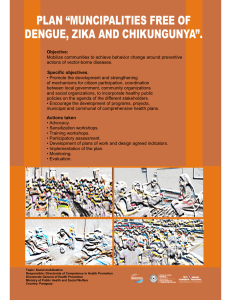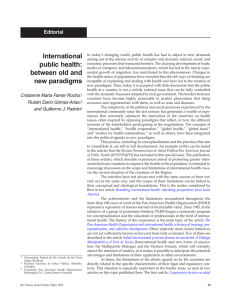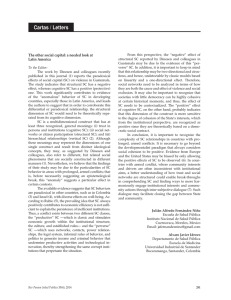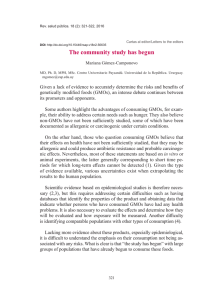Validity and reliability of the Work Ability Index in primary
Anuncio
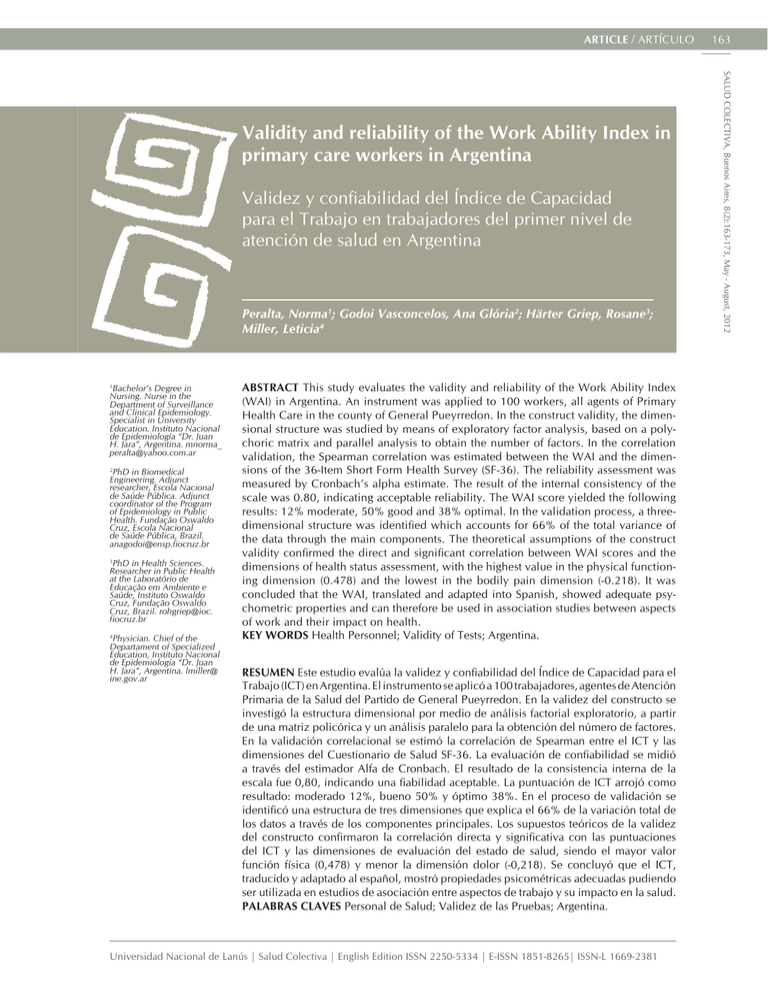
ArTICLE / ARTÍCuLo Validez y confiabilidad del Índice de Capacidad para el Trabajo en trabajadores del primer nivel de atención de salud en Argentina Peralta, Norma1; Godoi Vasconcelos, Ana Glória2; Härter Griep, Rosane3; Miller, Leticia4 1 Bachelor’s Degree in Nursing. Nurse in the Department of Surveillance and Clinical Epidemiology. Specialist in University Education. Instituto Nacional de Epidemiología “Dr. Juan H. Jara”, Argentina. mnorma_ peralta@yahoo.com.ar 2 PhD in Biomedical Engineering. Adjunct researcher, Escola Nacional de Saúde Pública. Adjunct coordinator of the Program of Epidemiology in Public Health. Fundação Oswaldo Cruz, Escola Nacional de Saúde Pública, Brazil. anagodoi@ensp.fiocruz.br 3 PhD in Health Sciences. Researcher in Public Health at the Laboratório de Educação em Ambiente e Saúde, Instituto Oswaldo Cruz, Fundação Oswaldo Cruz, Brazil. rohgriep@ioc. fiocruz.br 4 Physician. Chief of the Departament of Specialized Education, Instituto Nacional de Epidemiología “Dr. Juan H. Jara”, Argentina. lmiller@ ine.gov.ar AbSTrACT This study evaluates the validity and reliability of the Work Ability Index (WAI) in Argentina. An instrument was applied to 100 workers, all agents of Primary Health Care in the county of General Pueyrredon. In the construct validity, the dimensional structure was studied by means of exploratory factor analysis, based on a polychoric matrix and parallel analysis to obtain the number of factors. In the correlation validation, the Spearman correlation was estimated between the WAI and the dimensions of the 36-Item Short Form Health Survey (SF-36). The reliability assessment was measured by Cronbach’s alpha estimate. The result of the internal consistency of the scale was 0.80, indicating acceptable reliability. The WAI score yielded the following results: 12% moderate, 50% good and 38% optimal. In the validation process, a threedimensional structure was identified which accounts for 66% of the total variance of the data through the main components. The theoretical assumptions of the construct validity confirmed the direct and significant correlation between WAI scores and the dimensions of health status assessment, with the highest value in the physical functioning dimension (0.478) and the lowest in the bodily pain dimension (-0.218). It was concluded that the WAI, translated and adapted into Spanish, showed adequate psychometric properties and can therefore be used in association studies between aspects of work and their impact on health. kEy WordS Health Personnel; Validity of Tests; Argentina. rESUMEN Este estudio evalúa la validez y confiabilidad del Índice de Capacidad para el Trabajo (ICT) en Argentina. El instrumento se aplicó a 100 trabajadores, agentes de Atención Primaria de la Salud del Partido de General Pueyrredon. En la validez del constructo se investigó la estructura dimensional por medio de análisis factorial exploratorio, a partir de una matriz policórica y un análisis paralelo para la obtención del número de factores. En la validación correlacional se estimó la correlación de Spearman entre el ICT y las dimensiones del Cuestionario de Salud SF-36. La evaluación de confiabilidad se midió a través del estimador Alfa de Cronbach. El resultado de la consistencia interna de la escala fue 0,80, indicando una fiabilidad aceptable. La puntuación de ICT arrojó como resultado: moderado 12%, bueno 50% y óptimo 38%. En el proceso de validación se identificó una estructura de tres dimensiones que explica el 66% de la variación total de los datos a través de los componentes principales. Los supuestos teóricos de la validez del constructo confirmaron la correlación directa y significativa con las puntuaciones del ICT y las dimensiones de evaluación del estado de salud, siendo el mayor valor función física (0,478) y menor la dimensión dolor (-0,218). Se concluyó que el ICT, traducido y adaptado al español, mostró propiedades psicométricas adecuadas pudiendo ser utilizada en estudios de asociación entre aspectos de trabajo y su impacto en la salud. PALAbrAS CLAVES Personal de Salud; Validez de las Pruebas; Argentina. universidad Nacional de Lanús | Salud Colectiva | English Edition ISSN 2250-5334 | E-ISSN 1851-8265| ISSN-L 1669-2381 SALud CoLECTIVA, Buenos Aires, 8(2):163-173, May - August, 2012 Validity and reliability of the Work Ability Index in primary care workers in Argentina 163 SALud CoLECTIVA, Buenos Aires, 8(2):163-173, May - August, 2012 164 PErALTA N, GodoI VASCoNCELoS AG, HärTEr GrIEP r, MILLEr L INTRODUCTION The scope that the concept of health has acquired in recent years has come to include the influence of working conditions and individual perception of discomfort and dissatisfaction as core components of the concept of quality of life. This shift in perspective is crucial to the area of staff management, faced with the challenge of determining whether there are influential factors that may stimulate or inhibit an individual’s work process throughout their working life or that may condition their health in the future (1-7). The concept of “work ability” was devised in order to more fully acknowledge those who generate resources, allowing for the development of specific indicators in the workplace associated with measurements of physical and mental demands, organizational structures, and work environment. This concept expresses …what a worker’s ability is or will be like in the present or future, as well as how he or she will be able to perform his/her job in accordance with the requirements posed by his/ her health conditions and his/her physical and mental capabilities. (8) [Own translation] The implementation of the Work Ability Index (WAI) is based on workers’ health, the aging process of the working population, the conservation of active employees’ well-being, and quality of life at the time of retirement (9). Finland has pioneered WAI research, where it emerged as a way of evaluating the current performance of workers and of estimating their individual health conditions with the aim of improving them, taking into consideration whether their future capabilities will match job demands (9). According to Ilmarinen and Tuomi (8,10), the WAI has allowed for progress in the adjustment of individual capacities to the skills required of a given job, which in turn impacts stress reduction and the optimization of worker efficiency, thereby increasing the likelihood of preservation of both mental and physical health, in addition to a better quality of life (9). Since 1981, the WAI has been used in several countries both in research and practice, and it has been translated into more than 24 languages, among which Cuba’s Spanish version can be found (10). It was not possible to identify studies on the psychometric properties of the WAI in Argentina, which is of fundamental importance if it is to be used when studying the association between this index and health events in a given country. This study evaluates the validity and reliability of the Spanish version of the WAI in Argentina. METHODS Study population A cross-sectional epidemiological study was conducted during July of 2010. The population consisted of 152 professionals who work in Primary Health Care in the 24-hour health centers of the Municipal Health System of the county of General Pueyrredon. One hundred people effectively participated in the study, with nonparticipation owing to the following: refusal to participate in the study (n=29, 19.08%), medical leave (n=12, 7.89%), and difficulties in locating individuals (n=11, 7.23%). Of the total number of workers that agreed to participate in the survey, 72% were female, 59% were either married or partnered, 31% were single, 8% were separated, and 2% were widowed. Regarding profession, 35% were doctors, 26% were nurses, and 39% had different professions related to primary health care (psychologists, dentists, pharmacists, social workers, etc.). The average age of the studied population was 39.01 years, with a range of 24 to 64 years of age. Respondents had worked in the municipality for an average of 8.61 years (standard deviation=8.89 years) and had worked continuously at the same health center for an average of 4.75 years (standard deviation= .58 years.) The average tenure of temporary staff was 1.57 years (n=20; standard deviation=1.24 years), and for the permanent staff the average was 7.62 years (n=80; standard deviation=7.72 years). Of these workers 67% held other jobs, 45% of which were not related to the municipal government. Universidad Nacional de Lanús | Salud Colectiva | English Edition ISSN 2250-5334 | E-ISSN 1851-8265| ISSN-L 1669-2381 Validity and reliability of the Work Ability Index For the purposes of assessing the semantic equivalence of the English to Spanish translation of the WAI instrument developed in Cuba, three experts were selected based on their accredited command of health terminology in both languages. The main objective was to test the ten questions that constitute the scale with respect to the meanings of the terms used in the translation. To validate the translation the following criteria were used: 1.Regarding general terminology, whether it was altered in the translation (altered/not altered). 2.Regarding literal terms, whether there was change of meaning. students would be familiar with issues related to workers’ health and security. The training had the following objectives: To prepare the team of field workers for the implementation of the survey. To provide the team with the know-how and technical training required to implement this methodology. To provide knowledge about the study population, their work location and geographical distribution within the Municipality of General Pueyrredon. To provide information regarding the contents of each item on the survey. The validation was based on the following Likert scale: 5 strongly agree; 4 agree; 3 neutral (affirmation); 2 disagree; 1 strongly disagree. These objectives are important given that the attitude and behavior of the team of field workers could potentially have an influence both on the quality of the information as well as the ability of the group to obtain quantitative responses from the population. Instrument used to measure WAI Pretest of the instrument The WAI questionnaire consists of seven dimensions and ten questions from which the score is obtained (11) (Table 1). The final result ranges between 7 and 49 points. The calculation of the global score takes into account the sum of the scores obtained in each question per Table 1 (12). Finally, the respondent is classified in terms of his or her work ability into the following categories: poor (7-27); moderate (28-36), good (37-43) or ideal (44-49). The pretest was conducted with 15 people, who were subsequently not included in the study. It was carried out by surveying the staff of a national health agency that performs similar functions to those of the studied population. Table 1. Dimensions used in the measurement of the Work Ability Index. Dimensions Interviewers’ training During the research process the structured questionnaire was administered, having been previously codified. This was done primarily in two ways: written bibliographic material was prepared (detailing the type of terminology used in the survey), and three interviewers were selected from a group of advanced students in the Associate’s Degree Program in Workplace Safety and Hygiene [Tecnicatura de Seguridad e Higiene en el Trabajo] at a private university, given that these SALud CoLECTIVA, Buenos Aires, 8(2):163-173, May - August, 2012 Examining the translation of the instrument Work Ability Index Total 1. Subjective estimation of current work ability compared to the best work ability in life 0-10 2. Subjective estimation of work ability related to work demands (physical and mental) 2-10 3. Current number of diagnosed illnesses 1-7 4. Subjective estimation of work limitations due to illnesses 1-6 5. Absence from work and school due to illness during last year 1-5 6. Personal forecast for work ability in the next two years 1-7 7. Mental resources (enjoyment of daily tasks, optimism about the future) 1-4 Range 165 7-49 Source: Tuomi (12). Universidad Nacional de Lanús | Salud Colectiva | English Edition ISSN 2250-5334 | E-ISSN 1851-8265| ISSN-L 1669-2381 SALud CoLECTIVA, Buenos Aires, 8(2):163-173, May - August, 2012 166 PErALTA N, GodoI VASCoNCELoS AG, HärTEr GrIEP r, MILLEr L The application of the pretest had the following goals: To determine the time that the interview takes. To determine if the questions were clear enough for interpretation by the interviewees (information obtained through an interviewer). DATA ANALYSIS Construct validity of the WAI Construct validity (a), established through a series of techniques that aim to assess the degree to which empirical measures accurately reflect the concept in question (13), was assessed through correlational and factorial validation. With regards to correlational validation, respondents took the WAI survey as well as the SF-36 Health Survey (14). The latter is considered to be a psychometrically solid method to measure health from a subjective standpoint, and it is widely used around the world and has been validated in Argentina. Its purpose was to compare the perception of personal health by means of factor analysis. Correlational validation was estimated using Spearman’s correlation (with a level of significance of 5%) to verify the correspondence between the WAI and the scale dimensions of SF-36. The dimensional structure or factorial validation, part of construct validation, was evaluated through exploratory factor analysis, a statistical technique based on the assumption that a series of observed or measured variables (called empirical or observational variables) can be explained by a smaller number of hypothetical non-observable variables called factors (15). The factorability of the data was evaluated using the Kaiser-Meyer-Olkin index (KMO) (16), which indicates the percentage of variance shared by all variables, and is considered to be useful when dealing with small sample sizes. Low KMO values would indicate that the use of the WAI is not recommendable. The criteria adopted for the validation of the test were: 1 to 0.9, very good; 0.9 to 0.8, good; 0.8 to 0.7, medium; 0.7 to 0.6, reasonable; 0.6 to 0.5, weak; <0.5, unacceptable. Parallel analysis was used in order to identify the number of factors to be retained (b) (1). An exploratory factor analysis was then conducted using the principal component method, and a factor loading cutoff of 0.40 was stipulated. For the matrix rotation of factor loading, the method of orthogonal varimax rotation was employed. While most of the variables that compose the WAI are ordinal categorical, with the exception of the variable “current work ability compared to the best work ability in life,” which is a continuous variable, polychoric correlations (c) (among ordinal variables) and point biserial correlation (d) (continuous and ordinal variables) were used for the factor analysis. Reliability in this study was assessed through internal consistency (e) using Cronbach’s alpha for the global score and also on an item-per-item basis (18). Ethical aspects The study was approved by the Bioethics Committee of the Dr. Juan H. Jara National Institute of Epidemiology [Instituto Nacional de Epidemiología “Dr. Juan H. Jara”] and the Ethics Committee of the Municipality of General Pueyrredon, before giving their support to the project. Each worker gave his or her written consent before conducting the interview. RESULTS Examining the translation of the Work Ability Index The experts agreed to classify the comparison of the translations of the questions from English into the Cuban version into three categories: equivalent items (use of the same syntactic properties and lexical choices as the source text); items with slight modifications (different word choice, but without modification of the meaning of the question); and non-equivalent items (the translation presented different wording and interpretation). Differences were found in only two questions with slight alterations in word choice that did not affect their meaning. Universidad Nacional de Lanús | Salud Colectiva | English Edition ISSN 2250-5334 | E-ISSN 1851-8265| ISSN-L 1669-2381 Validity and reliability of the Work Ability Index Table 2. Distribution of responses by score obtained in the different WAI dimensions, Spanish version. Municipality of General Pueyrredón, Mar del Plata, 2010. Dimensions Score 0 1 2 3 4 5 6 7 8 9 10 Total 1. Work ability compared to the best work ability in life 0 0 0 1 1 3 4 16 39 15 21 100 2. Work ability related to job demands - - 0 0 0 3 6 12 35 23 21 100 3. Current number of illnesses diagnosed by a physician - 3 4 7 17 25 - 44 - - - 100 4. Estimated work loss due to illness - 0 0 3 18 41 38 - - - - 100 5. Absences from work due to illness in the last twelve months - 0 3 5 26 66 - - - - - 100 6. Personal forecast for work ability in the next two years - 0 - - 4 - - 96 - - - 100 7. Mental resources - 0 8 29 63 - - - - - - 100 Source: Own elaboration. Universidad Nacional de Lanús | Salud Colectiva | English Edition ISSN 2250-5334 | E-ISSN 1851-8265| ISSN-L 1669-2381 SALud CoLECTIVA, Buenos Aires, 8(2):163-173, May - August, 2012 Parallel analysis by principal components indicated three factors to be extracted. This coincides with the number of eigenvalues greater than one, another of the criteria commonly used for this purpose. As shown in Table 3, the three extracted factors accounted for 66% of the total variance of the data (f). If 0.50 is taken as the cutoff level for factor I, it comprises the following items: “Work ability compared to the best work ability in life”; “Work ability with repect to the physical work demands,” “Work ability with respect to the mental work demands,” “Feeling of being active and alert,” and “Hope for the future,” with an eigenvalue of 3.46, thereby accounting for 31% of the total variance. Factor II, composed by “Absences at work due to illness in the last twelve months” and “Personal forecast for work ability in the next two years,” had an eigenvalue of 1.72, accounting for 18% of the total variance. Factor III, which includes “Current number of illnesses diagnosed by a physician” and “Estimated work loss due to illness,” had an eigenvalue of 1.23 and accounted for 17% of the total variance. The item “Enjoyment of daily activities” had similar factor loadings in factors I and II (0.55 and 0.50, respectively). Table 2 shows that the study population obtained high values in the different dimensions of the WAI. Most workers obtained the three highest scores in the dimensions “Work ability compared to the best work ability in life” (75%) and “Work ability related to job demands” (79%). Nearly 44% stated having no illnesses currently diagnosed by medical professionals, 3% reported five or more illnesses, 38% stated suffering from no illness that would impede fulfillment of their duties, and 4% considered themselves able to do their job despite showing some symptoms. Many of the workers (66%) indicated absence from work due to illness and 96% obtained the highest score in terms of personal forecast for their work ability two years from now. Lastly, 63% of the workers obtained the highest score in terms of mental resources (the ability to enjoy daily activities, the perception of being active and alert, and the feeling of hope for the future). There was no low WAI score present in the study population (7-27 points); 12% of respondents obtained a moderate score (28-36), 50% good (37-43), and 38% ideal (44-49). Kaiser-Meyer-Olkin test results (KMO = 0.70) indicated that the data were adequate for factor analysis (19). 167 SALud CoLECTIVA, Buenos Aires, 8(2):163-173, May - August, 2012 168 PErALTA N, GodoI VASCoNCELoS AG, HärTEr GrIEP r, MILLEr L Table 4 shows the reliability of the Work Ability Index as measured by Cronbach’s alpha. The total value of this coefficient was 0.80 and the exclusion of any particular question did not alter the results significantly. Regarding construct validation of the correlational aspect, the WAI showed a statistically significant correlation (p < 0.01) with all of the dimensions related to health status on the SF-36 Health Survey. Taking into account that better health status yields a higher WAI value, these correlations would be expected. The highest were physical function (PF) 0.478, emotional role (ER) 0.43, and mental health (MH) 0.41. The WAI also displayed an inverse correlation with pain (-0.22), which shows that lower levels of pain yield higher WAI values (Table 5). Table 3. Analysis of the three principal components of the Work Ability Index through varimax rotation (n=100). Dimensions Questions Principal components Factor I Factor II Factor III Communality 1 Q1. Assume that your work ability at its best has a value of 10 points. How many points would you give your current work ability? 0.64 0.25 0.10 0.48 2 Q2a. How do you rate your current work ability with respect to the physical demands of your work? 0.78 -0.08 0.18 0.64 Q2b. How do you rate your current work ability with respect to the mental demands of your work? 0.80 -0.09 0.16 0.67 3 Q3. In the following list, mark your current diseases or injuries. Also indicate whether a physician has diagnosed or treated these diseases. 0.12 0.14 0.92 0.88 4 Q4. Is your illness or injury a hindrance to your current job? 0.27 0.40 0.81 0.88 5 Q5. During the last 12 months: how many whole days have you been off work? (Absences from work due to illness in the last 12 months.) -0.06 0.63 0.37 0.53 6 Q6. Do you believe, according to your present state of health, that you will be able to do your current job two years from now? 0.21 0.92 -0.15 0.91 7 Q7a. Considering the last three months: Have you been able to enjoy your regular daily activities? 0.55 0.50 0.02 0.56 Q7b. Considering the last three months: Have you been active and alert? 0.75 0.23 -0.02 0.62 Q7c. Considering the last three months: Have you felt yourself to be full of hope about the future? 0.64 0.15 0.09 0,.4 Component variance 0.31 0.18 0.17 Component variance 0.31 0.49 0.66 Source: Own elaboration. Universidad Nacional de Lanús | Salud Colectiva | English Edition ISSN 2250-5334 | E-ISSN 1851-8265| ISSN-L 1669-2381 Validity and reliability of the Work Ability Index Items Cronbach’s alpha when question is excluded Q1. Work ability compared to the best work ability in life 0.78 Q2a. Work ability for the job with respect to the physical job demands 0.78 Q2b. Work ability for the job with respect to the mental job demands 0.78 Q3. Current number of illnesses diagnosed by a physician 0.81 Q4. Estimated work loss due to illness 0.77 Q5. Absences from work due to illness in the last twelve months 0.81 Q6. Personal forecast for work ability in the next two years 0.79 Q7a. Enjoyment of daily activities 0.78 Q7b. Feeling of being active and alert 0.77 Q7c. Hope for the future 0.78 Total 0.80 Source: Own elaboration. DISCUSSION Considering the current context of changes in production processes, labor relations, and the aging of the working population, issues related to health workers’ ability become increasingly important, and this investigation sets a precedent in that it provides a starting point for future applications and analyses of the evolution of the WAI measured in the region. Given that the survey to be implemented had been translated in Cuba, a standard corroboration methodology for the English to Spanish translation was used. This methodology involved the analysis of experts who verified semantic equivalences and equivalences in the meanings of words or in the translation of expressions (20). The majority of the study population obtained a good or moderate WAI score, while 38% obtained an ideal score. Epidemiological studies on the relationship of age to the premature loss of work ability (21) have shown that this variable does not contribute to different outcomes regarding the loss of work ability, which confirms the results obtained in this study. Studies on the dimensional structure of the WAI have obtained different results. This study has identified, by means of principal component analysis, that the items can be converted into three dimensions, which account for 66% of the total variance. In Brazil, a study conducted by Martínez et. al. (22) with the participation of electricity workers, identified three factors with eigenvalues higher than one by means of principal component analysis, accounting for 57.9% of variance. Almeida da Silva Junior (23), also utilizing principal components and varimax rotation, extracted two factors that accounted for 53% of data variance among nursing professionals. Regarding factorial structure, the first factor identified in this study combines the items in a similar way to Almeida da Silva Junior (23), another study dealing with healthcare professionals. In Martínez et al. (22) the first factor with 20.6% of the total variance combined the elements “Enjoyment of daily activities,” “Feeling of being active and alert,” and “Hope for the future,” all of which correspond to the “Mental resources” dimension. The second factor, with 18.9% of total variance, consisted of the elements “Work Table 5. Spearman’s correlation of the global Work Ability Index with dimensions from the SF-36 Health Survey. Dimensions of the 36-Item Short Form Health Survey (SF-36) r p-value Physical function 0.478 <0.01 Physical role 0.316 <0.01 Pain -0.218 <0.05 Health 0.287 <0.01 Vitality 0.323 <0.01 Social function 0.364 <0.01 Emotional role 0.423 <0.01 Mental health 0.421 <0.01 Source: Own elaboration. Universidad Nacional de Lanús | Salud Colectiva | English Edition ISSN 2250-5334 | E-ISSN 1851-8265| ISSN-L 1669-2381 SALud CoLECTIVA, Buenos Aires, 8(2):163-173, May - August, 2012 Table 4. Cronbach’s alpha values when each item is excluded and in the global score of the Work Ability Index in primary care workers. Municipality of General Pueyrredón, Mar del Plata, 2010 (n =100). 169 SALud CoLECTIVA, Buenos Aires, 8(2):163-173, May - August, 2012 170 PErALTA N, GodoI VASCoNCELoS AG, HärTEr GrIEP r, MILLEr L ability compared to best work ability in life,” “Work ability related to physical job demands,” and “Work ability related to mental job demands,” which represent the worker’s perception of his or her ability to work. The third factor, with 18.4% of total variance, was composed of the elements “Current number of illnesses diagnosed by a physician,” “Estimated work loss due to illness,” “Absences at work due to illness in the last twelve months,” and “Personal forecast for work ability in the next two years,” which are related to the presence of illnesses and the restrictions imposed by health status. The inquiry into correlational validity showed that the dimensions of SF-36 were correlated with the highest WAI value, equal to 0.48 (p < 0.01), which in turn showed a tendency of higher work ability scores correlating with better assessments of health status. It also displayed a negative correlation with pain (-0.218). These results would allow researchers to interpret that the construct “work ability,” understood as a worker’s ability to perform his or her tasks, is determined by physical and mental health conditions (12). All of the dimensions corresponding to health status were found to be statistically correlated with the WAI, with the dimensions “physical function,” “emotional role,” and “mental health” presenting stronger correlation. In general, physical health presents a stronger correlation with the WAI than the dimensions related to mental health (24). In this study, the inclusion of both dimensions is justified by the type of activity performed by the study population. The cross-sectional design of this study is not conducive to the inference of causal relations. Nonetheless, in order to explain the high levels of health and work ability among primary health care workers, the healthy worker effect must be taken into account. This concept alludes to the exclusion of workers who are more frequently ill or absent due to illness from the processes of recruitment for employment (25). This phenomenon is complex and difficult to measure, but it must be taken into account when evaluating the results of studies related to workers’ health (25) from the time of initial employment. Although the data in this study do not allow for this effect to be measured, it must not be disregarded given that the systematic use of this instrument could allow for the implementation of measures intended to preserve the work ability of the individuals involved. Despite satisfactory levels of health status and work ability observed in this study, follow-ups on the health status of the workers – including periodic medical checks and the evaluation of work ability through the WAI and SF-36 – would allow for individual and collective monitoring, such that any changes could be detected early, allowing for the application of necessary measures to improve their working conditions. It is also worth noting the issue of workrelated stress, given that it is recommended to apply measures that aim to improve the organizational and psychosocial aspects of the work environment in order to attend to workers’ needs and expectations with respect to the necessities and demands of their daily tasks, even when the detected levels of stress are not high. On the other hand, it is necessary to consider other factors relating to work environment identified in the literature that are not contemplated by the WAI (which only covers the aspects related to the worker). Although the factors found in the WAI are central to determining the abilities, limitations, and needs of people, it largely ignores issues related to the characteristics of the workplace or the work environment (26,27). An indirect goal of WAI validation was to demonstrate its importance for preserving work ability, given that the aging of the population presents new challenges for the advancement of work ability. Therefore, stimulating work ability may contribute to increasing wellbeing and happiness as well as the overall quality of work. As the study population presents specific characteristics in terms of health profile (primary health care) and labor market insertion, the WAI results might not be valid for other occupational populations in Argentina. Therefore, the reliability of the instrument should be validated before use with other populations. Universidad Nacional de Lanús | Salud Colectiva | English Edition ISSN 2250-5334 | E-ISSN 1851-8265| ISSN-L 1669-2381 Validity and reliability of the Work Ability Index This project was financed by the Dr. Juan H. Jara National Institute of Epidemiology under the Dr. Carlos Malbrán National Laboratory Administration [Administración Nacional de Laboratorios “Dr. Carlos Malbrán”] of the Argentine Ministry of Health. ENDNOTES a. Construct validity (varimax rotation): Groups of items should be established statistically, defined as dimensions. The conceptualization of these dimensions should be based on consensus in order to render them useful and scientifically valid, given that there is no benchmark. If the domains have been constructed theoretically, statistical measures must validate the suitability of these groups. b. Parallel analysis (26): A procedure based on the principle that the factors to be extracted should reflect more variance than would be expected at random. The procedure randomly rearranges the observations among each variable and the eigenvalues are recalculated from that new, randomly ordered database. Factors with eigenvalues higher than the random values are retained for interpretation. c. Polychoric correlation: An estimate of the degree of linear relationship between two continuous latent variables to two variables of dichotomous or ordinal nature. Polychoric correlations do not assume normal multi-variant distribution of the observed variables nor of the latent variables. d. Point biserial correlation: The correlation coefficient applied when attempting to quantify the relation between an essentially dichotomous variable (such as sex), or conveniently dichotomized, with another quantitative variable. the accidental circumstances of measurement. It is based on the variance of the measured variable. There are several indices that measure reliability, such as Cronbach’s alpha and Kuder-Richardson (KR-20). Internal consistency is affected by the heterogeneity of the assessed individuals: the more heterogeneous the group, the higher the reliability coefficient. f. Communality: The proportion of the variance determined by the common factors. The initial communalities in the analysis of principal components always equal one; therefore this data does not provide significant information. On the other hand, in the final statistics, communality does carry significance. This is because at the end of the process there is no explanation of the total variance of each of the variables, given that only a small number of the possible factors were retained, and therefore the communality of each variable will represent the proportion of variance explained by the set of resulting final factors. The communality of each variable is estimated from the factor matrix and may range from zero to one. When a communality of zero is obtained, it means that the common factors do not provide any explanation for the variability of a variable. Conversely, if communality is equal to one, then the variable is fully explained by the common factors that appear in the factor matrix. Lastly, the variance that cannot be explained by the common factors is attributed to the unique factor, which does not appear in the factor matrix. e. Internal consistency (Cronbach’s alpha): the ability to obtain results that are independent from BIBLIOGRAPHIC REFERENCES 1. Karasek R, Theorell T. Health work, stress, productivity and reconstruction of working life. New York: Basic Books; 1991. 2. Gómez Vidal MA. Efectos tóxicos sobre la salud derivado de la exposición crónica a plaguicidas: Importancia de los marcadores bioquímicos. [Tesis de Doctorado] Granada: Facultad de Medicina, Universidad de Granada; 1999. 3. Hiba JC, director. Condiciones de trabajo, seguridad y salud ocupacional en la minería del Perú. Ginebra: Organización Internacional del Trabajo; 2002. Universidad Nacional de Lanús | Salud Colectiva | English Edition ISSN 2250-5334 | E-ISSN 1851-8265| ISSN-L 1669-2381 SALud CoLECTIVA, Buenos Aires, 8(2):163-173, May - August, 2012 ACKNOWLEDGEMENTS 171 SALud CoLECTIVA, Buenos Aires, 8(2):163-173, May - August, 2012 172 PErALTA N, GodoI VASCoNCELoS AG, HärTEr GrIEP r, MILLEr L 4. Mingote Adam JC. Satisfacción, estrés laboral y calidad de vida del médico. [Tesis de Doctorado]. Madrid: Universidad Autónoma de Madrid; 1994. 5. García Viniegras C, López Gonzalez V. Consideraciones teóricas sobre el bienestar y la salud. Revista Habanera de Ciencias Médicas. [Internet]. 2003-2004 [cited 10 Mar 2012];2(7). Available from: http://bvs.sld.cu/revistas/rhab/articulo_rev7/ carmen.html. 6. Robalino Campos M; Körner A. Condiciones de trabajo y salud docente: Estudios de casos en Argentina, Chile, Ecuador, México, Perú y Uruguay. Santiago de Chile: UNESCO; 2005. 7. Juárez García A. Factores psicosociales laborales relacionados con la tensión arterial y síntomas cardiovasculares en el personal de enfermería en México. Salud Pública de México. 2007;49(2):109-117. 8. Ilmarinen J, Tuomi K. Past, present and future of work ability. En: Ilmarinen J, Lehtinen S, editors. Past, present and future of work ability. Helsinki: Finnish Institute of Occupational Health; 2004. p. 1-25. (People and Work, Research Reports No. 65). 9. Ilmarinen J, Tuomi K, Eskelinen L, Nygård CH, Huuhtanen P, Klockars M. Background and objectives of the Finnish research project on aging workers in municipal occupations. Scandinavian Journal of Work, Environment & Health. 1991;17(Suppl 1):S7-S11. 10. Tuomi K, Huuhtanen P, Nykyri E, Ilmarinen J. Promotion of work ability, the quality of work and retirement. Occupational Medicine. 2001;51(5):318-324. 11. Ilmarinen J, Tuomi K. Work ability of aging workers. Scandinavian Journal of Work, Environment & Health. 1992;18(Suppl 2):S8-S10. 12. Tuomi K, Ilmarinen J, Jahkola A, Katajarinne L, Tulkki A. Índice de capacidade para o trabalho. Fischer FM, tradutor. São Carlos: EDUFSCar; 2005. 13. Griep RH, Chor D, Faerstein E, Werneck GL, Lopes CS. Validade de constructo de escala de apoio social do Medical Outcomes Study adaptada para o português no Estudo Pró-Saúde. Cadernos de Saúde Pública. 2005;21(3):703-714. 14. Alonso J, Prieto L, Anto JM. La versión española del SF-36 Health Survey (Cuestionario de Salud SF-36): un instrumento para la medida de los resultados clínicos. Medicina Clínica. 1995;104(20):771-776. 15. Pasquali L. Análise fatorial para pesquisadores. Brasília: LabPAM; 2005. 16. Mari JJ, Williams P. A validity study of a psychiatric screening questionnaire (SRQ-20) in primary care in the city of São Paulo. British Journal of Psychiatry. 1986;148:23-26. 17. Horn JL. A rationale and test for the number of factors in factor analysis. Psychometrika. 1965;30(2):179-185. 18. Revelle W. Psych: Procedures for Psychological, Psychometric, and personality research [Internet] 2012 [cited 10 May 2012]. Available from: http://www.personality-project.org/r/psych. manual.pdf. 19. Aaronson NK, Acquadro C, Alonso J, Apolone G, Bucquet D, Bullinger M, Bungay K, Fukuhara S, Gandek B, Keller S, et al. International quality of life assessment (Iqola) Project. Quality of Life Research. 1992;1(5):349-351. 20. Guillemin F, Bombardier C, Beaton D. Crosscultural adaptation of health-related quality of life measures: literature review and proposed guidelines. Journal of Clinical Epidemiology. 1993;46(12):1417-1432. 21. Ilmarinen J. Aging and work-coping with strengths and weaknesses. [Editorial]. Scandinavian Journal of Work, Environment & Health. 1997;23(Suppl 1):S3-S6. 22. Martinez MC, Latorre Dias de Oliveira MR. Validity and reliability of the Brazilian version of the Work Ability Index questionnaire. Revista de Saúde Pública [Internet]. 2009 [cited 4 Jul 2011];43(3). Available from: http://www.scielo.br/scielo.php?pid=S003489102009000300017&script=sci_ arttext&tlng=en. 23. Silva Junior SHA, Vasconcelos AGG, Griep RH, Rotenberg L. Validade e confiabilidade do índice de capacidade para o trabalho (ICT) em trabalhadores de enfermagem. Cadernos de Saúde Pública [Internet]. 2011 [cited 4 Jul 2011];27(6):10771087. Available from: http://www.scielo.br/scielo. php?script=sci_arttext&pid=S0102-311X20110 00600005&lng=pt. 24. Martinez MC, Latorre Dias de Oliveira MR. Saúde e capacidade para o trabalho de eletricitários do Estado de São Paulo. Ciência & Saúde Coletiva. 2008;13(3):1061-1073. 25. Nygård CH, Eskelinen L, Suvanto S, Tuomi K, Ilmarinen J. Associations between functional capacity and work ability among elderly municipal Universidad Nacional de Lanús | Salud Colectiva | English Edition ISSN 2250-5334 | E-ISSN 1851-8265| ISSN-L 1669-2381 VALIdITy ANd rELIAbILITy of THE Work AbILITy INdEx 26. García AM, Gadea R, Sevilla MJ, Genís S, Ronda E. Ergonomía participativa: emponderamiento de los trabajadores para la prevención de trastornos musculoesqueléticos. Revista Española de Salud Pública. 2009;83(4):509-518. 27. Catalano AM, Mendizábal N, Neffa JC. Condiciones y medio ambiente de trabajo y salud de los obreros de la industria del vidrio. Buenos Aires: Trabajo y Sociedad, PIETTE/CONICET, CREDAL/ CNRS, SOIVA; 1993. CITATIoN Peralta N, Godoi Vasconcelos AG, Härter Griep R, Miller L. Validity and reliability of the Work Ability Index in primary care workers in Argentina. Salud Colectiva. 2012;8(2):163-173. Received: 2 September 2011 | Revised: 1 February 2012 | Accepted: 30 March 2012 This work is licensed under the Creative Commons Attribution-NonCommercial 4.0 International License. Attribution — You must attribute the work in the manner specified by the author or licensor (but not in any way that suggests that they endorse you or your use of the work). Noncommercial — You may not use this work for commercial purposes. The translation of this article is part of an interdepartmental collaboration between the Undergraduate Program in Sworn Translation Studies (English <> Spanish) and the Institute of Collective Health at the Universidad Nacional de Lanús. This article was translated by Darío Damián Di Franco and Mariano Germán Saab, reviewed by Pamela Vietri and modified for publication by Joseph Palumbo. universidad Nacional de Lanús | Salud Colectiva | English Edition ISSN 2250-5334 | E-ISSN 1851-8265| ISSN-L 1669-2381 SALud CoLECTIVA, Buenos Aires, 8(2):163-173, May - August, 2012 employees. Scandinavian Journal of Work, Environment & Health. 1991;17(Suppl 1):S122-S127. 173

